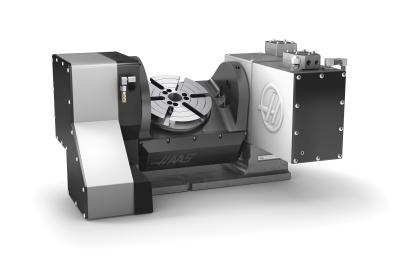
Five-axis machining is a powerful tool for reducing setup time and increasing accuracy for complex parts. But investing in a 5-axis machine tool can be prohibitively expensive, especially for smaller shops. The new TR200Y dual-axis trunnion rotary table from Haas Automation puts 5-axis capabilities well within reach of the average job shop, and its compact size provides greater mounting flexibility.
The TR200Y is designed to mount in the Y direction (front to back on the table) of a mid-size VMC. At less than 27" (686 mm) wide and only 20" (508 mm) deep, the TR200Y easily fits on one end of the machine’s table, freeing up the remainder for additional fixtures or vises. The TR200Y has a 200 mm (7.87") T-slot platter, and will swing parts up to 8.1" (206 mm) diameter. The maximum platter capacity is 80 lb (36 kg). The trunnion provides ±120 degrees of tilt and 360 degrees of rotation for full simultaneous 5-axis motion, or to position parts to almost any angle for machining. Yet, like all Haas rotary tables, it can easily be removed when not needed.
Powerful brushless servomotors provide 150 ft-lb (203 Nm) of spindle torque on both axes of the TR200Y. Brake torque is 300 ft-lb (407 Nm) on the tilt axis and 100 ft-lb (136 Nm) on the rotary axis; speeds are 130 deg/sec on the rotary axis and 100 deg/sec on the tilt axis. The trunnion’s precision-ground platter of heat-treated 4140 alloy steel has six standard 5/8" (16 mm) T-slots equally spaced at 60 degrees for easy fixturing.
Plug-and-play compatibility makes connecting the TR200Y to a Haas mill with 4th- and 5th-axis drives a breeze, and the available programmable servo control makes it easy to interface the rotary to almost any machine.
Contact Details
Related Glossary Terms
- milling machine ( mill)
milling machine ( mill)
Runs endmills and arbor-mounted milling cutters. Features include a head with a spindle that drives the cutters; a column, knee and table that provide motion in the three Cartesian axes; and a base that supports the components and houses the cutting-fluid pump and reservoir. The work is mounted on the table and fed into the rotating cutter or endmill to accomplish the milling steps; vertical milling machines also feed endmills into the work by means of a spindle-mounted quill. Models range from small manual machines to big bed-type and duplex mills. All take one of three basic forms: vertical, horizontal or convertible horizontal/vertical. Vertical machines may be knee-type (the table is mounted on a knee that can be elevated) or bed-type (the table is securely supported and only moves horizontally). In general, horizontal machines are bigger and more powerful, while vertical machines are lighter but more versatile and easier to set up and operate.
